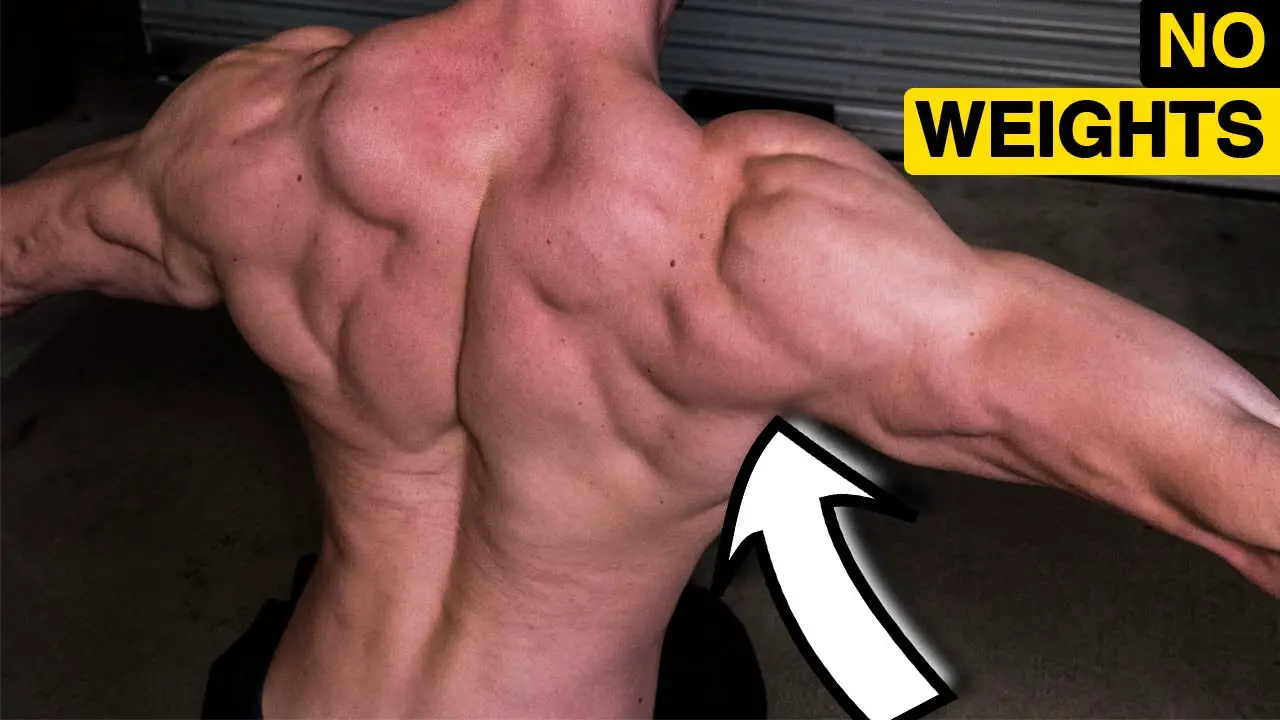Body weight rear delt exercises target the posterior deltoid muscles using only body weight. These exercises improve shoulder strength and posture.
Rear deltoid exercises are essential for balanced shoulder development. Strong rear delts enhance upper body strength and improve overall posture. Exercises like reverse flyes, prone Y raises, and face pulls can be done without weights. They engage the posterior deltoids effectively, contributing to a well-rounded shoulder workout.
Incorporating these exercises into your routine can prevent muscle imbalances and reduce the risk of shoulder injuries. Consistency is key for seeing improvements in strength and muscle definition. Always ensure proper form to maximize benefits and avoid strain.
Introduction To Rear Deltoid Muscles
The rear deltoid muscles are crucial for balanced shoulder strength. They are located at the back of your shoulders. These muscles help in various movements and maintain shoulder health.
Importance In Overall Shoulder Health
Strong rear delts support shoulder joints. They prevent injuries by balancing the front and middle delts. This balance is essential for overall shoulder health.
| Benefits | Description |
|---|---|
| Injury Prevention | Reduces risk of shoulder injuries |
| Improved Stability | Enhances shoulder stability |
| Balanced Strength | Balances front and middle delts |
Role In Posture And Aesthetics
Rear deltoids play a key role in maintaining good posture. They help pull the shoulders back and align the spine. This alignment is crucial for a healthy posture.
From an aesthetics perspective, strong rear delts add to the overall shoulder definition. They make your shoulders look well-rounded and balanced. This balance enhances your upper body appearance.
- Enhances shoulder definition
- Supports good posture
- Contributes to balanced upper body

Credit: bodyweighttrainingarena.com
Benefits Of Strengthening The Rear Delts
Strengthening the rear delts has many benefits. It improves shoulder health and upper body strength. Let’s explore these benefits in detail.
Enhanced Shoulder Stability
Strong rear delts help stabilize your shoulders. Stability prevents injuries and enhances performance. It also helps maintain good posture.
Shoulder stability is crucial for many activities. This includes lifting, throwing, and pushing. A stable shoulder is a healthy shoulder.
Improved Upper Body Strength
Rear delt exercises boost upper body strength. They target muscles often ignored. This leads to balanced muscle development.
Stronger rear delts support other muscles. This includes the chest, back, and arms. Overall upper body strength improves with strong rear delts.
| Benefit | Description |
|---|---|
| Shoulder Stability | Prevents injuries and supports shoulder functions. |
| Upper Body Strength | Enhances overall muscle strength and balance. |
Common Mistakes In Rear Delt Training
Training your rear delts can be challenging. Many people make mistakes that hinder progress. Knowing these mistakes helps you train better and avoid injury.
Neglecting Proper Form
Many people neglect proper form during rear delt exercises. This can lead to poor results and potential injuries. Always maintain a neutral spine and avoid arching your back. Use a controlled motion for each rep to target the rear delts effectively.
Here are some key points to remember:
- Keep your shoulders down and relaxed.
- Avoid swinging your arms; use slow, controlled movements.
- Engage your core throughout the exercise.
Proper form ensures you get the most out of your workout and reduces the risk of injury.
Overlooking Mind-muscle Connection
Mind-muscle connection is crucial for effective rear delt training. Many people overlook this aspect. Focus on feeling the rear delts work during each rep. This improves muscle activation and growth.
Try these tips for better mind-muscle connection:
- Visualize the rear delts contracting and relaxing with each movement.
- Slow down the reps to feel the muscle working.
- Use a mirror to watch your form and ensure correct muscle engagement.
Building a strong mind-muscle connection can significantly enhance your rear delt gains.

Credit: www.youtube.com
Bodyweight Exercises For Rear Delts
Strong rear delts improve posture and enhance shoulder stability. Bodyweight exercises can effectively target these muscles without any equipment. This makes them accessible to everyone. Below are some effective exercises to strengthen your rear delts.
Face Pull Alternatives
Face pulls are great but need equipment. Here are some bodyweight alternatives:
- Reverse Plank Bridge: Sit with your legs extended. Place hands behind you and lift your hips. Hold this position to engage the rear delts.
- Inverted Rows: Use a sturdy table. Lie beneath it and pull your chest towards the table. This targets the rear delts effectively.
- Superman T: Lie face down. Extend your arms to form a “T”. Lift your arms and chest. Hold for a few seconds then lower.
Ytwl Exercises
YTWL exercises target multiple parts of the shoulder. Each letter represents a different arm position:
- Y: Lie face down. Extend arms above your head to form a “Y”. Lift your arms and chest off the ground.
- T: From the same position, extend arms out to the sides to form a “T”. Lift your arms and chest.
- W: Bend your elbows and form a “W”. Lift your arms and chest.
- L: Bend your elbows to 90 degrees. Lift your arms and chest.
These exercises can be done in sequence or individually. They are perfect for a quick, effective workout. Incorporate these exercises to strengthen your rear delts without weights.
Incorporating Resistance Bands
Adding resistance bands to your body weight rear delt exercises can boost your workout routine. Resistance bands are simple tools but very effective. They are portable, versatile, and can be used anywhere. Below are some great exercises to incorporate resistance bands for your rear delts.
Band Pull-aparts
Band pull-aparts are excellent for targeting the rear delts. They help improve posture and shoulder health. Follow these steps to perform band pull-aparts correctly:
- Stand with your feet shoulder-width apart.
- Hold the resistance band in front of you at shoulder height.
- Keep your arms straight but not locked.
- Pull the band apart, moving your arms to your sides.
- Squeeze your shoulder blades together.
- Slowly return to the starting position.
Repeat for 10-15 reps. Ensure you keep the tension in the band throughout the exercise.
Reverse Flies With Bands
Reverse flies with bands are perfect for isolating the rear delts. This exercise also engages the upper back muscles. Here’s how you can do reverse flies with bands:
- Stand on the center of the resistance band with your feet hip-width apart.
- Hold the ends of the band with each hand.
- Bend slightly at the hips, keeping your back straight.
- Extend your arms in front of you, palms facing each other.
- Raise your arms out to your sides, forming a ‘T’ shape.
- Squeeze your shoulder blades together.
- Slowly lower your arms back to the starting position.
Perform 10-12 reps. Keep a slight bend in your elbows to reduce joint strain.
Incorporating these resistance band exercises into your routine will strengthen your rear delts effectively. You will notice improved muscle tone and better posture.
Leveraging Gravity For Intensity
Bodyweight rear delt exercises harness gravity to increase intensity. This makes workouts more challenging and effective. Utilizing body weight enhances muscle engagement. This method is perfect for building strength without equipment.
Inverted Rows
Inverted rows are excellent for targeting rear delts. This exercise requires minimal setup. All you need is a sturdy bar or table.
Follow these steps to perform inverted rows:
- Lie under a bar, grabbing it with both hands.
- Keep your body straight, engaging your core.
- Pull your chest towards the bar, squeezing your shoulder blades.
- Lower yourself back to the starting position.
Repeat for desired reps. Inverted rows effectively build rear delt strength. Adjust difficulty by changing the bar height.
Elevated Pike Push-ups
Elevated pike push-ups are another great rear delt exercise. This variation adds extra intensity by elevating your feet.
Here is how to perform elevated pike push-ups:
- Place your feet on an elevated surface like a chair.
- Position your hands on the ground, shoulder-width apart.
- Form a pike position, hips pointing upwards.
- Lower your head towards the ground, bending your elbows.
- Push back up to the starting position.
Elevated pike push-ups challenge your rear delts more. Adjust elevation height to increase or decrease difficulty.
Rear Delt Workouts Without Equipment
Strengthen your rear delts without any equipment. These workouts target the rear deltoid muscles. You can do them anywhere.
Floor-based Exercise Variations
Floor-based exercises are simple and effective. They require no equipment. You can do them at home or outside.
- Reverse Snow Angels: Lie face down. Extend your arms and legs. Lift them slightly off the ground. Move your arms in a snow angel motion.
- Prone T Raises: Lie face down. Extend your arms out to the sides. Lift your chest and arms off the ground. Hold and then lower back down.
- Rear Delt Push-ups: Start in a push-up position. Lower your body to the ground. Push up while focusing on your rear delts.
Wall-assisted Drills
Wall-assisted drills provide stability. They focus on rear delt activation. Use a sturdy wall for these exercises.
- Wall Slides: Stand with your back against the wall. Press your arms against the wall. Slide them up and down.
- Wall Shoulder Stretch: Stand facing the wall. Place your hands on the wall at shoulder height. Lean forward to stretch your rear delts.
- Wall Angels: Stand with your back against the wall. Keep your arms in a “W” position. Slide your arms up and down.

Credit: builtwithscience.com
Integrating Rear Delt Exercises Into Your Routine
Integrating rear delt exercises is essential for balanced shoulder development. These exercises help improve posture and shoulder stability. They also enhance your overall upper body strength.
Frequency And Volume Recommendations
For optimal results, target your rear delts 2-3 times per week. This frequency allows for adequate recovery and growth. Aim for 3-4 sets per exercise, with 10-15 reps per set.
Here’s a simple table to summarize:
| Frequency | Sets | Reps |
|---|---|---|
| 2-3 times/week | 3-4 sets | 10-15 reps |
Combining With Other Muscle Groups
Combining rear delt exercises with other muscle groups can save time and boost efficiency. Pair rear delt exercises with back or shoulder workouts.
Here’s a simple routine:
- Start with rear delt exercises.
- Move to back exercises like rows.
- Finish with shoulder presses or lateral raises.
Integrating these exercises creates a balanced and effective workout routine. This approach ensures all muscle groups get the attention they need.
Progression And Advanced Techniques
Progressing in body weight rear delt exercises can be challenging. Advanced techniques ensure continuous muscle growth and strength improvements. These techniques are essential for those aiming to push beyond basic exercises.
Progressive Overload Without Weights
Progressive overload is crucial for muscle growth. It involves gradually increasing the difficulty of exercises. Here are a few ways to achieve it without weights:
- Increase Repetitions: Start with a manageable number. Gradually add more reps as you get stronger.
- Decrease Rest Time: Shorten the rest period between sets. This keeps the muscles under tension longer.
- Change Angles: Adjust your body position. This can make the exercise harder and target different muscle fibers.
For example, moving from a standard plank to a decline plank engages the rear delts more intensely.
Isometric Holds For Strength
Isometric holds build strength without movement. They involve holding a position for a set time. Here are some effective isometric holds:
| Exercise | Position | Duration |
|---|---|---|
| Reverse Plank | Hold your body straight with hands behind | 20-60 seconds |
| Wall Sit with Arm Raise | Sit against a wall, arms raised to shoulder height | 30-60 seconds |
Incorporate these holds into your routine. Increase the duration gradually to challenge your muscles continuously.
Using these techniques will help you progress. Your muscles will grow stronger without the need for weights.
Maintaining Shoulder Health With Mobility Work
Maintaining shoulder health is crucial for overall upper body functionality. Mobility work plays a vital role in keeping shoulders strong and flexible. This section focuses on maintaining shoulder health with mobility work. Let’s dive into some effective body weight rear delt exercises.
Stretching For Rear Delts
Stretching is important for keeping the rear delts flexible. Here are some simple stretches:
- Cross-Body Stretch: Extend one arm across your chest. Use the opposite hand to gently pull the arm closer.
- Wall Stretch: Stand facing a wall. Place one arm against the wall and gently twist your body away.
- Child’s Pose with Arm Reach: Sit back on your heels and reach your arms forward. This stretch targets the rear delts and upper back.
Recovery Strategies
Recovery is key to maintaining shoulder health. Here are some effective strategies:
- Foam Rolling: Use a foam roller to massage the rear delts. This helps to release tension and improve blood flow.
- Rest Days: Allow your muscles to recover by taking rest days. This prevents overuse injuries.
- Hydration and Nutrition: Drink plenty of water and eat a balanced diet. Proper nutrition aids in muscle recovery.
| Exercise | Reps | Sets |
|---|---|---|
| Cross-Body Stretch | 10-15 seconds | 3 |
| Wall Stretch | 10-15 seconds | 3 |
| Child’s Pose with Arm Reach | 10-15 seconds |
3 |
Frequently Asked Questions
How To Train Rear Delts With Body Weight?
Train rear delts with body weight by doing reverse snow angels, prone T raises, and pike push-ups. Focus on form.
Do Bodyweight Rows Work Rear Delts?
Yes, bodyweight rows do work rear delts. They target the upper back, including the rear deltoids, effectively.
What Is The Best Rear Delt Exercise?
The best rear delt exercise is the bent-over reverse fly. It effectively targets and strengthens the rear deltoid muscles.
How To Target Rear Delts Without A Machine?
Perform bent-over reverse flyes, face pulls with a resistance band, and dumbbell rear delt rows to target rear delts.
Conclusion
Strengthening your rear delts with body weight exercises is effective and convenient. These moves can enhance your posture and shoulder health. Incorporate these exercises into your routine for balanced muscle development. Consistency is key to seeing results. Stay committed and enjoy the benefits of a stronger upper body.





